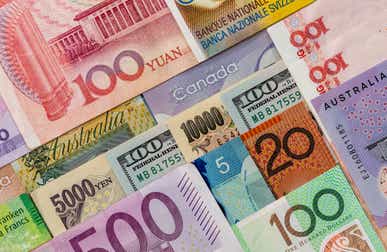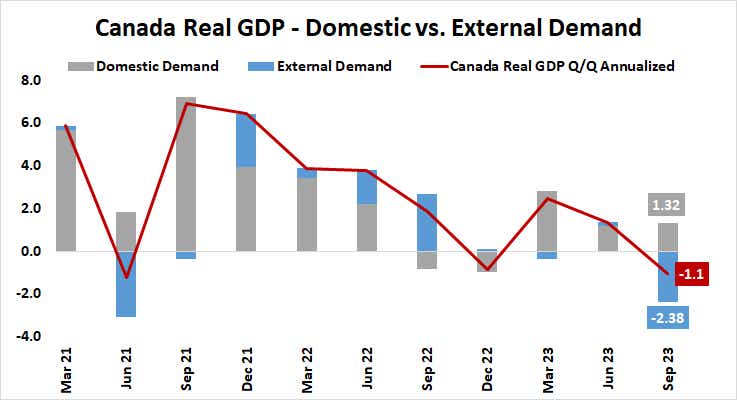Stocks at Risk, Dollar and Yen May Rise as Canada Flags U.S. Recession Risk

Stocks at Risk, Dollar and Yen May Rise as Canada Flags U.S. Recession Risk
By:Ilya Spivak
Wall Street may suffer if a dovish Bank of Canada fuels fear of a deepening slowdown in the United States and a global recession fears
- The Bank of Canada is seen as holding rates as the economy slows and inflation falls.
- Unexpectedly weak growth speaks to unraveling of demand in the U.S.
- A dovish policy guidance may fuel fears of recession fears and drive Wall Street lower.
Canada’s economy is in trouble.
Gross domestic product (GDP) unexpectedly fell at a blistering annualized rate of 1.1% in the third quarter, marking the worst performance since the three months ending in June 2021. Leading purchasing managers’ index (PMI) data paints an even darker picture thereafter. It shows economic activity shrinking at the fastest pace since May 2020.
Meanwhile, inflation has resumed moving lower after an unwelcome bounce over the summer. Consumer prices grew 3.1% year-on-year in October, marking a four-month low. The five-year breakeven rate—a measure of medium term inflation expectations priced into the bond market—has stabilized at 2%.
The housing market offers a still more dramatic disinflationary signal. “Shelter” is the largest component of the benchmark consumer price index (CPI). So, it isn’t surprising to see housing prices anticipating changes in overall inflation, with a lead of close to 10 months. They’ve been falling since April, setting the stage for the CPI to follow.
Canada to end rate hikes as economy suffers, inflation falls
The markets reckon that all this will keep the Bank of Canada (BOC) on the sidelines when Gov. Tiff Macklem and company deliver the results of December’s policy meeting this week. The priced-in probability of a 25-basis-point (bps) rate hike is a mere 6.5%.

In fact, no further tightening is seen on the menu. As with most of the world’s central banks, November marked a sharply dovish shift in the expected policy path, led by the Federal Reserve. The first 25bps BOC rate cut is due to appear no later than April. Three of them are fully baked into the outlook for 2024, with a 46% probability of a fourth.
A dovish adjustment may be in store as the central bank’s rhetoric nods at deteriorating economic conditions and hints more overtly that the tightening cycle has concluded. That would echo recent guidance from central banks in the Eurozone, the U.K., the U.S. and just this week in Australia.
Canada’s woes are a warning about U.S. growth
On the surface, that bodes ill for the Canadian dollar. Considered more broadly, however, a BOC retreat would amount to an ominous sign for the global macro economy. That’s because Canada’s business cycle is intimately in line with that of its southern neighbor, the United States.
That 1.1% annualized decline in Canadian third-quarter GDP nets out as an increase of 1.3% in domestic demand is overwhelmed by a 2.4% drop on the external side. The U.S. consumes a commanding 79% of Canada’s exports, so the outsized weakness there appears to speak volumes about the precarious state of the world’s largest economy.

The markets’ reaction to a dovish pivot from the Reserve Bank of Australia (RBA) just yesterday brought down the so-called “Aussie” dollar but also left local stocks with a loss on the day. This hints the markets are transitioning from celebrating incoming rate cuts in November to worrying about the malaise prompting them.
The sight of a defensive BOC within this context may then sound like a loudly shouted warning about the direction of global growth as demand in the U.S. unravels. That might bode ill for stocks at large—including on Wall Street—as well as cyclical commodities. The anti-risk Japanese yen and U.S. dollar are likely to rise against their peers.
Ilya Spivak, tastylive head of global macro, has 15 years of experience in trading strategy, and he specializes in identifying thematic moves in currencies, commodities, interest rates and equities. He hosts Macro Money and co-hosts Overtime, Monday-Thursday. @Ilyaspivak
For live daily programming, market news and commentary, visit tastylive or the YouTube channels tastylive (for options traders), and tastyliveTrending for stocks, futures, forex & macro.
Trade with a better broker, open a tastytrade account today. tastylive, Inc. and tastytrade, Inc. are separate but affiliated companies.
Options involve risk and are not suitable for all investors. Please read Characteristics and Risks of Standardized Options before deciding to invest in options.
tastylive content is created, produced, and provided solely by tastylive, Inc. (“tastylive”) and is for informational and educational purposes only. It is not, nor is it intended to be, trading or investment advice or a recommendation that any security, futures contract, digital asset, other product, transaction, or investment strategy is suitable for any person. Trading securities, futures products, and digital assets involve risk and may result in a loss greater than the original amount invested. tastylive, through its content, financial programming or otherwise, does not provide investment or financial advice or make investment recommendations. Investment information provided may not be appropriate for all investors and is provided without respect to individual investor financial sophistication, financial situation, investing time horizon or risk tolerance. tastylive is not in the business of transacting securities trades, nor does it direct client commodity accounts or give commodity trading advice tailored to any particular client’s situation or investment objectives. Supporting documentation for any claims (including claims made on behalf of options programs), comparisons, statistics, or other technical data, if applicable, will be supplied upon request. tastylive is not a licensed financial adviser, registered investment adviser, or a registered broker-dealer. Options, futures, and futures options are not suitable for all investors. Prior to trading securities, options, futures, or futures options, please read the applicable risk disclosures, including, but not limited to, the Characteristics and Risks of Standardized Options Disclosure and the Futures and Exchange-Traded Options Risk Disclosure found on tastytrade.com/disclosures.
tastytrade, Inc. ("tastytrade”) is a registered broker-dealer and member of FINRA, NFA, and SIPC. tastytrade was previously known as tastyworks, Inc. (“tastyworks”). tastytrade offers self-directed brokerage accounts to its customers. tastytrade does not give financial or trading advice, nor does it make investment recommendations. You alone are responsible for making your investment and trading decisions and for evaluating the merits and risks associated with the use of tastytrade’s systems, services or products. tastytrade is a wholly-owned subsidiary of tastylive, Inc.
tastytrade has entered into a Marketing Agreement with tastylive (“Marketing Agent”) whereby tastytrade pays compensation to Marketing Agent to recommend tastytrade’s brokerage services. The existence of this Marketing Agreement should not be deemed as an endorsement or recommendation of Marketing Agent by tastytrade. tastytrade and Marketing Agent are separate entities with their own products and services. tastylive is the parent company of tastytrade.
tastyfx, LLC (“tastyfx”) is a Commodity Futures Trading Commission (“CFTC”) registered Retail Foreign Exchange Dealer (RFED) and Introducing Broker (IB) and Forex Dealer Member (FDM) of the National Futures Association (“NFA”) (NFA ID 0509630). Leveraged trading in foreign currency or off-exchange products on margin carries significant risk and may not be suitable for all investors. We advise you to carefully consider whether trading is appropriate for you based on your personal circumstances as you may lose more than you invest.
tastycrypto is provided solely by tasty Software Solutions, LLC. tasty Software Solutions, LLC is a separate but affiliate company of tastylive, Inc. Neither tastylive nor any of its affiliates are responsible for the products or services provided by tasty Software Solutions, LLC. Cryptocurrency trading is not suitable for all investors due to the number of risks involved. The value of any cryptocurrency, including digital assets pegged to fiat currency, commodities, or any other asset, may go to zero.
© copyright 2013 - 2025 tastylive, Inc. All Rights Reserved. Applicable portions of the Terms of Use on tastylive.com apply. Reproduction, adaptation, distribution, public display, exhibition for profit, or storage in any electronic storage media in whole or in part is prohibited under penalty of law, provided that you may download tastylive’s podcasts as necessary to view for personal use. tastylive was previously known as tastytrade, Inc. tastylive is a trademark/servicemark owned by tastylive, Inc.